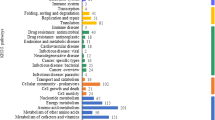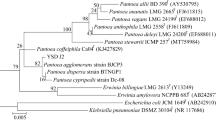Abstract
Pinoxaden is applied for weed control in the field to improve crop yield per unit area. This study assessed the methods to improve residual pinoxaden degradation in the soil. In this study, 14 strains were isolated from soil samples with pinoxaden as the only carbon and nitrogen source, and strain T4P20-1 exhibited high levels of pinoxaden degradation. The effects of different pH values, inoculation amounts, and cultivation times on the growth and degradation rate of strain T4P20-1 were studied. The optimal growth conditions of strain T4P20-1 were determined, and the degradation rate reached 92.23%. The morphological characteristics of strain T4P20-1 were determined by optical microscopy. Strain T4P20-1 was identified as Acinetobacter pittobacter based on its physiological and biochemical characteristics and 16S rDNA homology analysis. Through gene sequencing, the whole genome of strain T4P20-1 and GO, KEGG, COG, CAZymes, and PHI database annotations were obtained. The genes related to herbicide degradation were predicted by gene functional annotations. Herbicides can affect the germination and growth of the sensitive crops, and a negative correlation was noted between the herbicide concentration and the seed germination rate, bud length, and root length of maize. Thus, the strains screened in this study exhibited remediation effects on soil contaminated by pinoxaden. This information provides a new method for pinoxaden degradation in the future. This method can increase crop yields and reduce food security risks.






Similar content being viewed by others
REFERENCES
Adolfo, M. and Esteban, F.D., A review on pesticide removal through different processes, Environ. Sci. Pollut. Res., 2018, vol. 5, pp. 2051–2064.
Charniauskaya, M.I., Bukliarevich, A.A., Delegan, Y.A., Akhremchuk, A.E., Filonov, A.E., and Titok, M.A., Biodiversity of hydrocarbon–oxidizing soil bacteria from various climatic zones, Microbiology (Moscow), 2018, vol. 5, pp. 699–711.
Dian, C., Wu, S.R., Xue, H.A., and Jiang, J.D., Stereoselective catabolism of compounds by microorganisms: catabolic pathway, molecular mechanism and potential application, Int. Biodeterior. Biodegrad., 2020, vol. 146, pp. 104822–104834.
Han, H.D., She, Y.X., He, Y.J., He, Y.H., Wang, M.Q., Wang, M., Wang, S.S., Zheng, L.F., Cao, Z., Shao, H., Jin, M.J., Jin, F., Wang, J., and Gao, L.P., Simultaneous determination of residues of pinoxaden, acetylene and detoxine in barley by high performance liquid chromatography-tandem mass spectrometry, Food Sci., 2020, vol. 41, pp. 292–297. (in Chinese)
Kumar, S., Kaushik, G., Dar, M.A., Nimesh, S., Lopez-Chuken, U.J., and Villarreal-Chiu, J.F., Microbial degradation of organophosphate pesticides: a review, Pedosphere, 2018, vol. 28, pp. 190–208.
Li, Q.M., Li, S.Z., Zhang, Y.H., Li, C., Lu, Z.X., Chi, X.C., and Fu, Y., Control effect and safety evaluation of 4% pinoxaden and difluorosulfochlor OD on weeds in wheat field, Anhui Nongye Kexue, 2021, vol. 49, pp. 128–165. (in Chinese)
Maitra, S., DBP biodegradation kinetics by Acinetobacter sp. 33F in pristine agricultural soil, Environ. Technol. Innovation, 2021, vol. 21, p. 101240.
Mayer-Helm, B., Method development for the determination of 52 pesticides in tobacco by liquid chromatography–tandem mass spectrometry, J. Chromatogr. A, 2009, vol. 51, pp. 8953–8959.
Nuran, Y. and Yakup, S.V., Effects of processing and storage on pesticide residues in foods, Crit. Rev. Food Sci. Nutr., 2020, vol. 60, pp. 3622–3641.
Ou, J., Liu, K.L., Ou, X.M., Zeng, L.H., Yang, Z.F., Peng, J.H., and Liang, J., Determination of pinoxaden residue in water and soil by high performance liquid chromatography, Pesticides, 2020, vol. 59, pp. 901–905. (in Chinese)
Pan, L.W., Siegrist, R.L., and Crimi, M., Effects of in situ remediation using oxidants or surfactants on subsurface organic matter and sorption of trichloroethene, Groundwater Monit. Rem., 2012, vol. 32, pp. 96–105.
Sanaullah, M., Usman, M., Wakeel, A., Cheema, S.A., Ashraf, I., and Farooq, M., Terrestrial ecosystem functioning affected by agricultural management systems: a review, Soil Tillage Res., 2020, vol. 196, pp. 104464–104474.
Santillan, J.Y., Rojas, N.L., Ghiringhelli, P.D., Nobile, M.L., Lewkowicz, E.S., and Iribarren, AM., Organophosphorus compounds biodegradation by novel bacterial isolates and their potential application in bioremediation of contaminated water, Bioresour. Technol., 2020, vol. 317, pp. 124003–124045.
Sarlak, Z., Khosravi, D.K., Rouhi, M., Garavand, F., Mohammadi, R., and Sobhiyeh, M.R., Bioremediation of organophosphorus pesticides in contaminated foodstuffs using probiotics, Food Control, 2021, vol. 126, pp. 108006–108018.
Shalini, V., Dharam, S., and Subhankar, C., Biodegradation of organophosphorus pesticide chlorpyrifos by Sphingobacterium sp. C1B, a psychrotolerant bacterium isolated from apple orchard in Himachal Pradesh of India, Extremophiles, 2020, vol. 24, pp. 897–908.
Singh, A.K., Flounders, A.W., Volponi, J.V., Ashley, C.S., Wally, K., and Schoeniger, J.S., Development of sensors for direct detection of organophosphates. Part I: Immobilization, characterization and stabilization of acetylcholinase and organophosphate hydrolase on silica supports, Biosens. Bioelectron., 1999, vol. 14, pp. 703–713.
Singh, S., Kumar, V., Gill, J.P.K., Datta, S., Singh, S., Dhaka, V., Kapoor, D., Wani, A.B., Dhanjal, D.S., Kumar, M., Harikumar, S.L., and Singh, J., Herbicide glyphosate: toxicity and microbial degradation, Int. J. Environ. Res. Public Health, 2020, vol. 17, pp. 7519–7536.
Soares, P.R.S., Birolli, W.G., Ferreira, I.M., and Porto, A.L.M., Biodegradation pathway of the organophosphate pesticides chlorpyrifos, methyl parathion and profenofos by the marine-derived fungus Aspergillus sydowii CBMAI 935 and its potential for methylation reactions of phenolic compounds, Mar. Pollut. Bull., 2021, vol. 166, pp. 112185–112196.
Tan, X. and Zhang, X.D., Observation and differentiation of bacteria by Gram staining, Biol. Teach., 2019, vol. 44, pp. 71–72. (in Chinese)
Verma, J.P., Jaiswal, D.K., and Sagar, R., Pesticide relevance and their microbial degradation: a-state-of-art, Rev. Environ. Sci. Biotechnol., 2014, vol. 13, pp. 429–466.
Xu, D.Q., Wang, Y.M., and Zhou, D.Q., Laboratory Course in Microbiology, Higher Education Press, 2019, 4th ed. (in Chinese)
Yang, F.S., Sun, C., Tang, R.Y., Ma, Y.K., Fu, H.Y., and Liu, C.G., Screening and degradation capacity determination of two strains of benzotrone degrading bacteria, Chin. J. Biol., 2020, vol. 37, pp. 55–58. (in Chinese)
Yang, G., Characters and application of pinoxaden, Pesticide Market Information, 2011, vol. 0, p. 38. (in Chinese)
Yang, L., Chen, K., Wang, B.N., Liao, C.X., Wei, J., and Xie, Y., Determination of pinoxaden and alkynyl in water by high performance liquid chromatography–tandem mass spectrometry, Chem. Anal. Meas., 2020, vol. 29, pp. 15–18. (in Chinese)
Ye, X.L., Dong, F., and Lei, X.Y., Microbial resources and ecology‒microbial degradation of pesticides, Nat. Res. Conserv. Research, 2018, vol. 1, pp. 22–28.
Zaranyika, M.F., Matimati, E., and Mushonga, P., Degradation kinetics of DDT in tropical soils: a proposed multi-phase zero order kinetic model that takes into account evaporation,hydrolysis, photolysis, microbial degradation and adsorption by soil particulates, Sci. Afr., 2020, vol. 9, pp. 467–479.
Zhang, H.Y., Yuan, X.Z., Xiong, T., Wang, H., and Jiang, L.B., Bioremediation of co-contaminated soil with heavy metals and pesticides: influence factors, mechanisms and evaluation methods, Chem. Eng. J., 2020, p. 125657.
Zhang, Y.X., Xu, Z.X., Chen, Z.J., and Wang, G.J., Simultaneous degradation of triazophos,methamidophos and carbofuran pesticides in wastewater using an Enterobacter bacterial bioreactor and analysis of toxicity and biosafety, Chemosphere, 2020, vol. 261, pp. 128054–1228062.
Zhao, S.M., Xu, W., Zhang, W.L., Wu, H., Guang, C., and Mu, W.M., In depth biochemical identification of a novel methyl parathion hydrolase from Azohydromonas australica and its high effectiveness in the degradation of various organophosphorus pesticides, Bioresour. Technol., 2021, vol. 323, pp. 124641–124650.
Zhen, M.N., Song, B.R., Liu, X.M., Chandankere, R., and Tang, J.C., Biochar-mediated regulation of greenhouse gas emission and toxicity reduction in bioremediation of organophosphorus pesticide contaminated soils, Chin. J. Chem. Eng., 2018, vol. 26, pp. 2592–2600.
ACKNOWLEDGMENTS
This work was supported by the Key Laboratory of Molecular Biology and Key Laboratory of Microbiology, College of Heilongjiang Province.
Funding
This research was funded by the National Key Research and Development Program of China (grant number 2017YFD0201703), the Heilongjiang Natural Science Foundation Research Team Project (grant number TD2019C002), and the University Nursing Program for Young Scholars with Creative Talents in Heilongjiang Province (grant number UNPYSCT 2017119).
Author information
Authors and Affiliations
Contributions
Conceptualization: F.Y. and W.Z.; Methodology: F.Y. and C.L.; Software: C.S. and Y.W.; Validation: C.S., Y.W., C.L., and F.Y.; Formal analysis: F.Y., M.Y., and Y.W.; Investigation: C.L., H.F., and C.S.; Resources: C.L. and C.S.; Data curation: Y.W. and C.S.; Writing—original draft preparation: C.S. and F.Y.; Writing—review and editing: Y.W. and C.L.; Visualization: Y.W. and C.S.; Supervision: F.Y., H.F., and C.L.; Project administration: F.Y. and C.L.; Funding acquisition: F.Y. All authors have read and agreed to the published version of the manuscript.
Corresponding authors
Ethics declarations
The authors declare that they have no conflicts of interest.
This article does not contain any studies involving animals or human participants performed by any of the authors.
Supplementary Information
Rights and permissions
About this article
Cite this article
Yang, F., Wei, Y., Sun, C. et al. Pinoxaden Degradation Characteristics of Acinetobacter pittobacter and Prediction of Related Genes. Microbiology 91, 818–830 (2022). https://doi.org/10.1134/S002626172210109X
Received:
Revised:
Accepted:
Published:
Issue Date:
DOI: https://doi.org/10.1134/S002626172210109X




